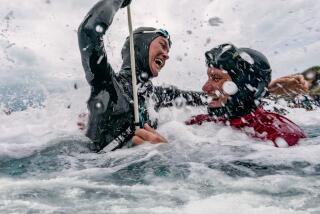Look Out Below : With a Spear and a Deep Breath, Skin Diver Hunts the Big Fish
Sustained only by the air in his lungs, skin diver Terry Maas lingered in the watery universe 30 feet beneath the waves and watched the two tuna far below his spear gun suddenly bolt in opposite directions.
Something was wrong.
Ominous thumping sounds, the kind made when monstrous fish tear the water with their tails, had been resonating up from the depths for a couple of seconds and now began to grow louder, closer.
“He came so fast, I couldn’t focus on him at first,” recalled Maas, an oral surgeon from Ventura. “It was me and my spear, and he and his own spear.”
In a flash of blue and bone, a 10-foot marlin charged from the deep and shot vertically toward Maas like a torpedo, its three-foot sword coming within inches of his heart before the 500-pound fish pulled up short. It later began to circle him in bland amusement as the stunned diver drifted to the surface.
“It looked like he was going to spear me,” said Maas, 50, one of the world’s foremost blue-water hunters who can hold his breath more than three minutes and reach depths of 100 feet.
But plumbing the deep--a sport within itself in which men plummet to 400 feet on lungs full of air--is not Maas’ primary focus.
Spearfishing is, ever since he won his first spearfishing competition at age 17 off Santa Cruz, Calif.
From the cold waters ringing the Channel Islands to the dazzling reefs of Africa and Australia, to the blue Mexican depths that teem with skipjack and wahoo, yellow fin and dorado, Maas has stalked--and landed--trophies that divers could only fantasize about a generation ago. Two of his catches, a 398-pound bluefin tuna in 1982 and a 256-pound yellow fin tuna in 1984, are world records that still stand.
The secret is stealth, silence and patience--infinite, almost reptilian patience--along with luck.
“You can’t go out for the fish,” Maas said. “They’re too fast. You have to wait for them to come to you.”
“Free divers are the Indians of our times,” he added. “You’ve got to know the game you’re hunting. . . . You’re armed only with the bow and arrow (the spear gun) and the air in your lungs.”
*
Drawn to the most unexplored wilderness on Earth--the blue desert of the open ocean--Maas epitomizes the tight fraternity of divers who eschew scuba tanks and the shallows to venture into water thousands of feet deep and miles from land.
There, without the protection of grottoes or kelp gardens or the confusing congress of shore life, the fish are fast--as fast as 55 m.p.h.--and big. They can get so unwieldy that divers must deploy strings of floats to buoy the giants they spear and stay vigilant of great whites and other sharks drawn to the blood and the thrashing.
That happened a decade ago off Mexico.
After dive partner Rene Rojas speared a large wahoo that played out 100 feet of Rojas’ spear line, a pack of sharks exploded from the depths, parting a thick cloud of skipjacks that had been schooling around the divers. Maas expected the four to five man-sized sharks to angle for the struggling wahoo.
They did not. Instead, they made for the two startled divers, who formed a back-to-back defense and jabbed their spear guns at the white-tipped sharks as they darted in and out in a blur of teeth and frustration.
“Imagine being in a forest surrounded by wolves,” Maas said. “That’s bad enough because they can come from all sides. But imagine them coming from the sky or out of the earth as well, which is what’s going on in the water. That’s almost impossible to defend against.”
The 30- to 60-second bout ended when one of the sharks suddenly streaked toward the fish on Rojas’ spearhead. Within seconds, Maas said, the others followed and “the wahoo just disappeared.”
The empty spear vanished into the blue below.
“What makes the open water so special is that there are fish out there that are still just as wild as they were eons and eons ago, before man was even around,” Maas said.
“And open water is the only place left on Earth--not mountains, not jungles, not deserts--where you can still see primitive, undisturbed wildlife,” he said.
Take the marlin. Never seen by divers who ply kelp beds and rocky bottoms, these quintessential game fish encounter humans only in their dying moments in the open sea, only while being gaffed and hauled aboard fishing boats.
Maas, to his astonishment, had a one-in-a-million opportunity after the blue marlin began to circle him that day in November, 1993, off the Mexican coast--and passed it up.
“He turned sideways, about five feet away, and presented the best kill shot you could ever have,” said Maas, whose high-powered, six-foot spear gun was aimed at the marlin.
But he did not fire. Still unsure why, he noted, “I was so impressed with the majesty of the fish.” He added that the meat of marlins is not considered to be especially tasty, “and we generally don’t spear anything we can’t eat.”
Though silent to the ears of the layman, the undersea world is full of sound and vibration, Maas said. He even is convinced that fish can feel the beating of an excited diver’s heart, a tip-off that can alert quarry and pique predators, such as sharks.
“You do it over and over again, and your heart adapts. Your breathing adapts. Everything adapts,” said Maas, whose equipment typically includes mask, snorkel, fins, weight belt and wet suit. “Even a very good beginning diver can have a problem when he finally does see a big fish. All the training goes out the window then. Heart rates increase, and the diver’s forced to surface prematurely.”
*
Keep your cool, in other words. Relax. Blend into the blue. Become so non-threatening that fish of biblical size might drift up to you, their curiosity dulling the skittishness that otherwise would consign them to the shadows beyond reach.
Crucial to luring such giants, Maas said, is the diver’s emancipation from the noise of scuba tanks and their bothersome tether of bubbles that trail to the surface. With nothing but the air in his lungs, Maas has been able to stay underwater for up to 40 minutes out of an hour, submerging 25 to 60 feet for about 90 seconds at a time and resting for about 30 seconds between dives. He has done this for three hours straight.
“Free divers have for the most part been in the background for over 40 years,” Maas said. “Scuba diving is a big-money sport, so the commercial interests all tend to be toward scuba. . . . It has pushed free diving so far in the background (that) we have 40 years of untold stories to draw on.”
Maas’ first book, “Blue Water Hunting and Spearfishing,” which he plans to publish in early 1995, will include many such accounts.
While acknowledging that there might be critics of spearfishing, Maas added: “A lot of people have come around to see just how sportsmanlike it is to go out in the open ocean to do this, to do it in the conditions that we do.”
To reach his offshore hunting grounds, he can board his 26-foot converted abalone boat in Ventura and within about an hour of his dental practice drop anchor off Anacapa Island, his favorite local spot. His wife, 35-year-old Beth, has dived with him, he said, as have his children from an earlier marriage, Michael, 19, and Loren, 12.
The silence, after the pounding of the boat engine, can be almost numbing, Maas said, and the water as clear as a swimming pool or as murky as a London fog. Game fish are plentiful in warm months and sparse in cold ones.
Admittedly “skinny” at 6 feet, 1 inch and 158 pounds, Maas is vulnerable to the cold, he said, and can be chilled to the bone even while wearing his two wet suits, one fitted within the other. Six consecutive hours in local waters can do that. So can the 47-degree water of Puget Sound off Washington, where he dived while competing in a spearfishing championship.
Although he has never seen a great white shark in the wild, Maas arms himself in local waters with an explosive cartridge that can be attached to his spearhead.
Two months ago, he had been videotaping sea life in the waters off San Miguel Island, about 70 miles west of Ventura, close to where a sea-urchin diver was killed on Dec. 9 by what authorities suspect was a great white shark.
“I knew exactly where I was; that it was going to be dangerous,” said Maas, who was featured on a recently rerun KCET special, “Blue Water Hunters.”
“I had the same feeling that I sometimes get when something’s out there but I can’t see it. . . . It was dark, blackish water, with lots of seals (the prey of the great white shark), and being there raised the hackles on the back of my neck.”
*
Another time he had that feeling off Mexico.
While skimming the surface with a spear gun in one hand and a camera in the other, Maas scanned for tuna. Then he happened to look behind him.
“I shuddered and spastically jerked,” he said, noting that just past his fins was one of the most feared killers of the tropical seas, a 14-foot tiger shark.
Equally frightened, the shark also “shuddered and spastically jerked,” Maas said.
“I (filmed) him disappearing into the gloom with a belly that looked like two of me could have fit into it.”
More to Read
Sign up for Essential California
The most important California stories and recommendations in your inbox every morning.
You may occasionally receive promotional content from the Los Angeles Times.










